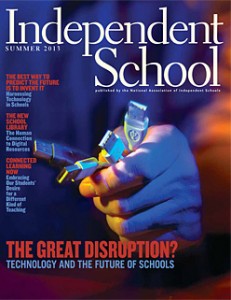 “The Great Disruption: Technology and the Future of Schools”
“The Great Disruption: Technology and the Future of Schools”
The latest issue of Independent School magazine is out and it’s a good one.
Among many good articles there is this from retiring NAIS president Pat Bassett: The Third Great American Revolution.
It’s a stirring call for action, almost a manifesto – for educators to rise to the challenge of our times, stand in awe of this moment in time and then seize the opportunites that lie before us.
The first revolution culminated in the momentous events of 1775 and 1776 with the Declaration of Independence. the second was the Civil Rights movement of the 1960’s and its apex at the March on Washington in 1963.
I believe that the third great transformational revolution in America — and, indeed, the world — is upon us, enabled by the Internet and the new technologies that open up limitless possibilities for how we live and work, and most important, how we teach and learn.
This third revolutionary game-changer is made possible by the advent of the Internet, particularly by the democratized access to information and knowledge, and the ability of literally anyone to be a creator of information and knowledge. It is a great equalizer — a tool fueling a new vision of human society.
In the networked world, how we define school and what we know about teaching and learning is changing, Bassett says. The MacArthur Foundation has identified five great shifts happening related to learning — all of which are made possible or accelerated ubiquitous technology and access to information and connection.
Connie Yowell – Director of Education Grantmaking at the John D. and Catherine T. MacArthur Foundation – puts it this way:
Connected learning is an answer to three key shifts as society evolves from the industrial age of the 20th century and its one-size-fits-all factory approach to educating youth to a 21st century networked society:
1) A shift from education to learning. Education is what institutions do, learning is what people do. Digital media enable learning anywhere, anytime; formal learning must also be mobile and just-in-time.
2) A shift from consumption of information to participatory learning. Learning happens best when it is rich in social connections, especially when it is peer-based and organized around learners’ interests, enabling them to create as well as consume information.
3) A shift from institutions to networks. In the digital age, the fundamental operating and delivery systems are networks, not institutions such as schools, which are one node of many on a young person’s network of learning opportunities. People learn across institutions, so an entire learning network must be supported.
Connected learning is not about technology. The principles of connected learning weren’t born in the digital age, but they are extraordinarily well-suited to it.
Connected learning is not about turning our backs on teachers and schools. Thousands of teachers and educators across the U.S. are working hard, often in the face of adversity, to reimagine learning for the next generation.
Connected learning is also not about throwing out traditional literacy skills. The importance of reading, writing and critical thinking are as important as ever. But so are new literacies like advanced problem-solving and collaboration that will be critical in the increasingly interconnected world we dwell in.
Connected Learning: Reimagining the Experience of Education in the Information Age
These shifts are from knowing to doing, from teacher-centered classes to student-centered learning, from the individual to the team, from consumption of information to the making of meaning, from schools to networks, and from single-sourcing knowledge to crowd-sourcing are expanded in the NAIS sidebar below.
A quick looks shows that these “shifts” connect with what a Poughkeepsie Day School education has always stood for and what it has always strived to achieve. Connected learning breathes new life into our traditional model and design.
| Old Model | Examples | New Model | Examples |
|---|---|---|---|
| Knowing | Memorizing facts for a pen and paper test | Doing | Applying knowledge and skills in a demonstration of learning |
| Teacher-centered | Textbook-derived lecture | Student-centered | Student-led seminar and partner “labs” in all disciplines |
| The Individual | Competition for grades, honor roll, and class rank | The Team | Collaboration in a project-based learning context |
| Consumption of Info | Knowledge is expendable with a short shelf-life | Construction of Meaning | Knowledge is a means to produce long-term meaning |
| Schools | Place-bound: learn inside the box of the classroom | Networks | Schools without borders: learn in the local and global communities digitally and/or via expeditions |
| Single Sourcing | Dated information with single point of view being the source of information and knowledge — the textbook | Crowd Sourcing | Experts with multiple perspectives and points of view produce and curate information — Wikipedia, etc. |
Pat Bassett sees many independent schools in the vanguard of these teaching and learning changes and helping to lead this third American (and global) revolution.
Revolutionaries are dreamers, he says, and sometimes revolution is dangerous and hard. Certainly that was true of the American revolution and the struggle for Civil Rights. The danger in this third revolution resides in inaction – a failure to seize this moment to reimagine and reinvent schools that can serve the needs of our students and our future.
Thanks Pat and every good wish for your retirement. Looking forward to what you have to say next!


